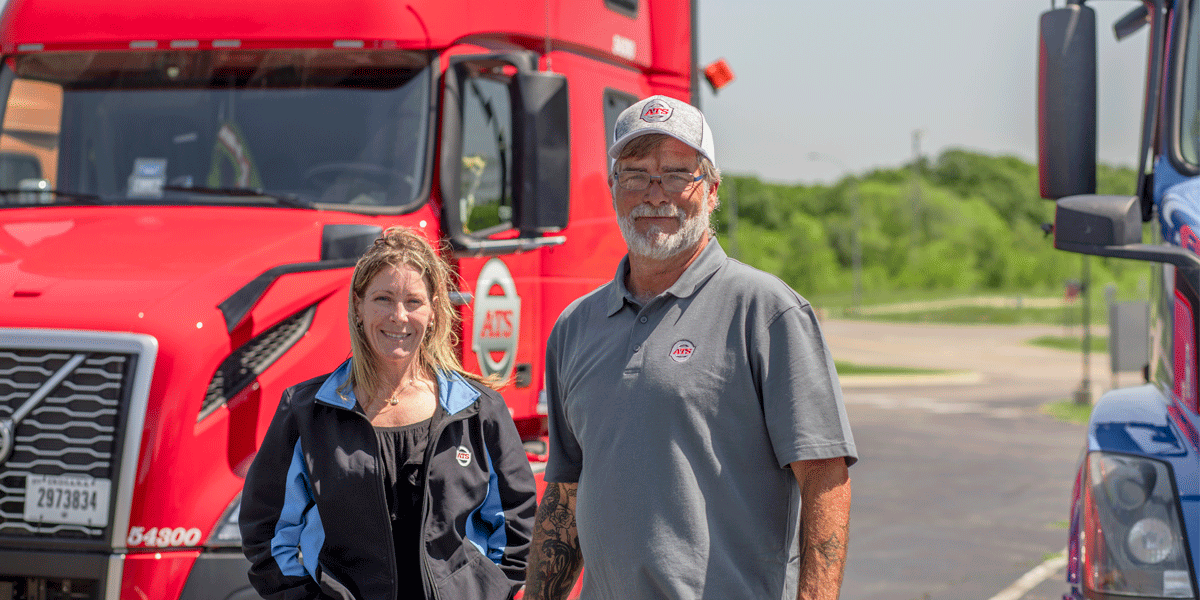What is a Driver Manager and How Can They Make Drivers Successful?
Jackie is a driver manager on the specialized side and works on wind projects. She works together with customer service representatives, permit coordinators and support departments to provide the best driver experience. She loves working as a team to ensure her drivers are safe, successful and happy. Drivers aren’t a number to Jackie. They’re very important people to her and she loves getting to know them, as well as working together to work through issues and helping them maximize productivity so they can make money to go home to their families. She started with ATS in July 2018. Prior to that, she worked in sales, where she focused on building long and lasting relationships.
Travel agent. Therapist. Punching bag. IT expert. Problem solver.
As a driver manager, sometimes we’re all five at once.
More than anything, it’s the job of a driver manager to support drivers on the road. Drivers and driver managers act as a team to excel together. It’s hard to succeed on your own without one or the other.
From the moment a driver manager arrives at the office in the morning to the moment they leave, they’re checking on their drivers to make sure they have all the tools they need to succeed and to ensure they’re making all of their deliveries.
As a driver, it’s easy to become frustrated with your driver manager, especially if you don’t understand exactly what they do and what they can help you with.
I’ve been a driver manager at Anderson Trucking Service (ATS) since 2018. During that time, I’ve managed a fleet of anywhere between 30 to 45 drivers. I focus on building strong, communicative working relationships with my fleet.
In this article, I’ll help you understand what a normal day looks like for me and other driver managers like me. In turn, you’ll understand how we can and can’t help you.
What is a Driver Manager?
A driver manager is an individual who acts as a liaison between truck drivers and the transportation company or fleet they work for. Driver managers typically work within the operations or dispatch department of a trucking company. Often, they manage a team of 25 to 40 drivers, but depending on the trucking company, they may work with more (or fewer) drivers.
The primary role of a driver manager is to oversee and coordinate the activities of the truck drivers. That includes building a strong relationship with their drivers and focusing on retention.
6 Main Responsibilities of a Driver Manager
Driver managers are responsible for assigning loads or routes to drivers (or at least talking through offers the planner provides them), ensuring timely deliveries, and optimizing the utilization of resources such as trucks and drivers.
Here are some key responsibilities of a driver manager in truck driving:
- Driver support
- Load assignment
- Communication
- Schedule management
- Problem-solving
- Compliance
Driver Support
Driver managers, above all, provide support and assistance to drivers, addressing their concerns, answering questions and addressing any challenges they may encounter on the road.
This is the number one thing I do all day. Everything leads up to this point — where I ensure they’re taken care of and supported.
A driver manager should be a driver’s resource for everything. Yes, big companies have a lot of different, specified departments, like a permit department and a settlement department. But, driver managers can help troubleshoot problems and speed up the process, therefore supporting drivers at every turn.
Load Assignment
Together with a planner or a customer service representative (CSR), driver managers assign loads or routes to drivers based on factors like customer requirements, delivery schedules, driver availability and equipment capacity.
It works differently at every company, but at ATS, there are planners for different regions. They look at drivers’ schedules to see when they’re delivering, when they’ll be empty next and if they have another load offer lined up. Once they see who’s available, they’ll send out offers to independent contractors. A company driver on forced dispatch won’t get multiple load offers. Obviously, they won’t just send any old load to a company driver. They’ll offer loads that are a good fit.
Driver managers review load offers for a few other things before they talk to a driver. They want to make sure a driver has the right trailer to haul the freight and they have the proper credentials. For instance, if a driver needs to pick up a container from a port, the driver manager will ensure they aren’t hauling a dry van trailer and they have their Transportation Worker Identification Credential (TWIC card).
Then, as a driver manager, I’ll talk through the offers with my drivers to make sure everything works out. I’ll advise them on why one load might be better than another or discuss the next loads I can get them on if they take this one.
Communication
Communication is the most essential part of a driver manager’s job. From the moment I sit at my desk in the morning to the moment I leave at night, I’m on the phone and answering emails. I’m always communicating with my fleet of drivers to make sure everything goes as smoothly as possible.
Driver managers maintain regular communication with drivers to provide instructions, updates and information about loads, routes, pickup/delivery locations and any changes or incidents that may affect the driver's schedule. Driver managers often work with shippers and receivers to communicate directions for arriving.
Communication is at the forefront of everything a driver manager does. Relationship-building is key to helping drivers succeed on the road.
Related: How to communicate with your driver manager
Schedule Management
Driver managers monitor and manage driver schedules, ensuring compliance with Hours of Service (HOS) regulations and optimizing driver productivity while considering factors like driver rest periods and equipment maintenance.
The moment I start my day, I’m checking my board to ensure my drivers are where they need to be. Are they going to make it to their appointment with the receiver for a delivery? Are they coming close to the end of their hours for the day?
Driver managers are in charge of ensuring drivers have their home time requests fulfilled, so they’ll help route you to the house.
They schedule shop visits too, to make sure drivers are getting preventative maintenance done on their trucks in a timely fashion.
Drivers are pulled in for random drug tests throughout the year. Driver managers (at least at some companies) are the ones who schedule a driver’s drug test appointment if they’re pulled for a random test. They ensure the driver has time to get to a nearby clinic and they can park safely.
Problem-Solving
When issues arise during a driver’s trip, such as mechanical breakdowns, accidents or delays, the driver manager assists in finding solutions. This may involve coordinating repairs, arranging alternate transportation, getting someone else to pick up the load or providing guidance on handling unexpected situations. Driver managers can even help solve problems with a driver’s electronic logging device (ELD).
There can also be other problems on the road, such as with a shipper/receiver. There are times when drivers and shippers/receivers clash. CSRs and driver managers often work together to calm the situation.
Problems do happen at home, too. It’s a driver manager’s job to work with their driver to get them home safely and on time.
Driver managers are solving problems all day.
Compliance
Driver managers work with support departments to ensure drivers adhere to all applicable regulations, including licensing, permits and documentation requirements. They may also help drivers with paperwork, such as logs, trip reports and fuel receipts. They also ensure drivers are following safety rules and they can help with securement tips.
For instance, ATS has a random securement program, where drivers need to send in securement photos for a special audit each quarter. The safety department and the driver manager receive and review the photos. Sometimes a driver might need help with securement, and the first place they can go is their driver manager for help.
Compliance is also at play. Some customers require securement photos to be sent in and approved before a driver can leave the shipper. This typically only occurs with highly specialized freight.
Compliance is also a factor when drivers are delivering to or picking up freight from customers with specific site regulations. For instance, a driver might not be allowed to have a partner or a pet in the truck. For certain jobs, a driver may need to be clean-shaven. As driver managers, we have to work through this with each driver.
Safety is a huge part of a driver manager’s job. For instance, at ATS, we have front-facing camera systems. Drivers receive points for safety violations or incidents. The footage is sent to the driver manager, who is responsible for helping to coach the driver on safe driving behaviors.

Driver Manager Training
Driver managers go through extensive training to make sure they can adequately support drivers. They aren’t thrown into the fold without any training.
For instance, ATS driver managers have a five-week onboarding training session before they start working with drivers. Driver managers also go through ongoing training. ATS driver managers, for instance, have a three-part training series that focuses on leadership and relationship building, driver coaching and management and interoffice collaboration.
That being said, everyone makes mistakes. Sometimes driver managers, planners and CSRs make mistakes. Sometimes a load is double-booked by the customer and it’s picked up before you get to it. All a driver manager can do at that point is try to find you a new load to get you moving again.
Driver managers can certainly help you navigate the market. There are definitely ups and downs in the industry and the market, but driver managers want to see you succeed.
I truly care about my drivers. I’m not in my seat without you. It’s my job to keep you happy, preloaded and moving. I also like to have a good working relationship with my drivers; it’s not just strictly business all the time. To be successful, we have to be trusting and communicative with one another.
As a driver, you have more power than you think. Make sure you advocate for yourself with your driver manager.
Related: ATS Driver Manager Training
Improve Your Driver Manager Relationship
Being a driver manager is a multifaceted role that encompasses various responsibilities and requires a diverse skill set. The primary focus of a driver manager is to provide unwavering support to drivers on the road, forming a symbiotic relationship where both parties strive for success together. They also work to keep drivers happy and retained.
Throughout the day, a driver manager dedicates their time to ensuring drivers have the necessary tools and resources to excel. This involves assigning loads or routes, coordinating timely deliveries, optimizing resource utilization and maintaining open lines of communication with drivers, shippers/receivers and other stakeholders. Additionally, driver managers actively assist drivers in addressing concerns, answering questions and overcoming challenges they may encounter during their journeys.
While driver managers strive to provide exemplary service, mistakes can occur. In such instances, they work diligently to rectify the situation and find alternative solutions.
By working in tandem with their driver managers, drivers can maximize their potential and navigate the industry successfully. The role of a driver manager is not just a job but an integral part of a team, driven by a shared goal of ensuring driver satisfaction and continuous progress.
Are you struggling to get along with your driver manager? These tips will help you improve your relationship with your driver manager.



